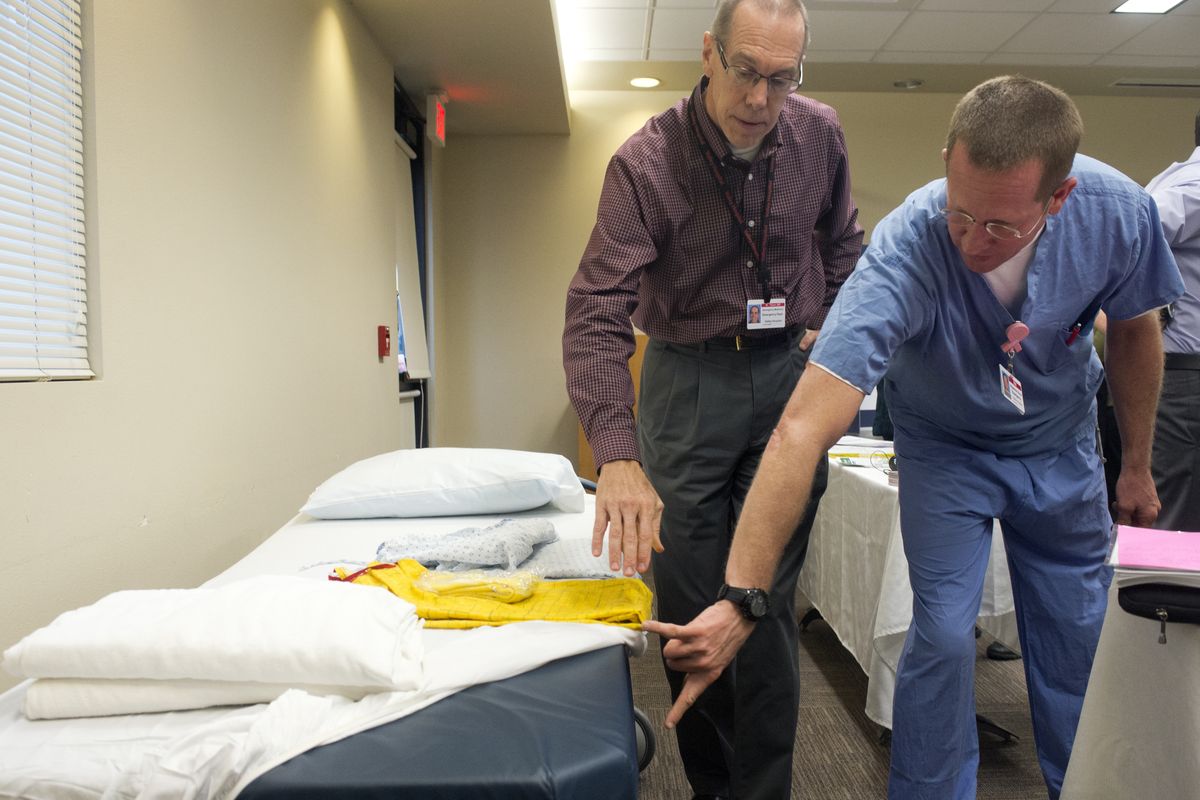Customized care
Emergency room changes at Deaconess and Valley hospitals cater to seniors’ needs

Bigger mattresses are a big deal in Valley Hospital’s emergency department, as part of its effort to create a “senior-friendly” ER.
At 5 inches thick, the mattresses – replacing the standard 3-inch-thick ones on the department’s 21 beds – are more comfortable, according to ER staff, and help protect patients’ fragile skin.
Other new features at Valley and Deaconess emergency departments touted last week at open houses include easier-to-use call buttons, floor-gripping socks and yellow gowns that alert staff to seniors’ higher risk of falling, and seniors-only parking spots or valet service.
Along with making customers happier, the changes at both hospitals are designed to cut the number of seniors’ repeat visits and the length of their hospital stays, Valley CEO Tim Moran told a group gathered at the hospital to see the improvements.
The hospitals, part of the region’s Rockwood Health System and owned by Community Health Systems Inc., have been making the changes as more patients grow older – and as the Affordable Care Act puts a new focus on improved ER care.
Under the new health care law, emergency departments have some new reasons – financial incentives and disincentives – to improve care, said Dr. Wayne Tilson, medical director of Valley Hospital’s emergency department.
Among disincentives, he said: They’re paid less to treat patients who continue to return to the ER, especially in the first 30 days after their first visit. The idea is that if emergency departments better address patients’ health-related problems – helping them set up better support at home, for example – they can prevent future ailments and injuries.
How much an ER gets reimbursed by Medicare also will depend partly on how quickly patients receive services and their satisfaction with their care, Tilson said.
In 2012, people 65 and older represented nearly 17 percent of Valley’s emergency department visits and nearly 20 percent at Deaconess. More elderly patients are expected as baby boomers age.
While the first wave of geriatric emergency departments – or designated senior sections within ERs – in the U.S. opened just a few years ago, senior care is getting more attention among emergency physicians in the U.S., Tilson said. Some ERs in regions with large senior populations – Arizona, Florida – are building entire divisions in their emergency departments for seniors, he said: “It’s just taken off.”
The efforts go beyond mattresses.
Chad Ziegenhagel, director of nursing for Valley’s ER, said staffers received training on medical problems frequently suffered by seniors and how to better communicate with them: Ask one question at a time. Sit down to talk, and enunciate. Involve family members in discussions.
And while Valley’s ER already had private rooms for emergency patients, Deaconess set aside a quiet area of its large, shared ER space for seniors.
The idea is to make it easier for senior patients to talk, hear and be heard – and for staff members to do a better job of learning patients’ overall medical histories and explaining their care to “address the overall problems rather than just the immediate stuff,” Tilson said.
Otherwise, senior patients can “bounce,” he said. “They come back later because the problem wasn’t addressed.”
Those problems often include social aspects of patients’ lives.
An elderly patient who lacks enough support to live at home is more likely to get sick or injured again, Tilson said, leading to repeat visits. But that’s a problem an ER social worker could help with.
“If you just look at the chief complaint – if you came in because you fell – you’re going to miss the whole big picture,” Tilson said.
It’s not slip-resistant floors and better lighting that cut down on repeat admissions, but what happens to patients after they’re discharged from the emergency department, said Dr. Joseph Guarisco. Guarisco leads the Milwaukee-based American Academy of Emergency Medicine’s operations management committee, which studies how emergency departments in the U.S. function and perform.
Guarisco is also chairman of emergency medicine at the Ochsner Medical Center in New Orleans, a system that in 2010 converted part of one of its seven emergency departments to focus on geriatric care. That department, at Ochsner’s Baptist campus, installed wooden, low-glare floors, bigger clocks and TVs and hand rails, traded up to thicker mattresses and trained its staff about seniors’ needs.
It’s also tried to cut back on seniors’ “front-end frustration,” Guarisco said, moving them directly to beds rather than through an extended triage process.
But he’s not convinced those features matter much in the long term for elderly patients, he said, compared with whether they get their medications, home health care and other support after leaving the hospital.
“Those things are going to make a difference,” Guarisco said. “That’s really where accountable care is headed – not typically what we did in the past. Outside of the ED or the hospital, you just sort of discharged patients and you said, ‘Good luck.’ That’s where readmissions come from, is the failure to support patients after they leave.”
Overall, elderly patients visit at twice the rate of the general population, Guarisco said. As a group, they stand to benefit from a special focus on their needs. But while geriatric ERs can be good for patients – and good for hospitals’ marketing efforts – the creation of geriatric ERs hasn’t been a big focus for the American Academy of Emergency Medicine, Guarisco said.
“A lot of those specialized functions, really every patient deserves – that’s the reality,” Guarisco said. “If you’re elderly or sick, you’re really in the same boat. Really what we’re doing for geriatrics, we ought to be doing for every patient. That’s making it safer, more comfortable, more friendly.”